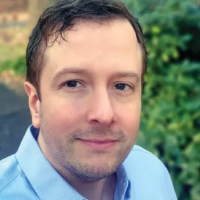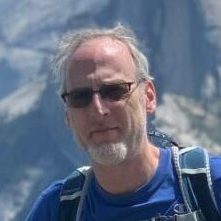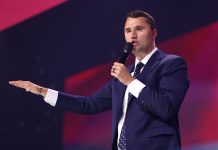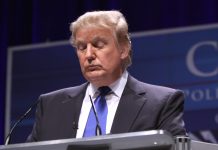Lance deHaven-Smith (nee Smith) was born in Atlanta Georgia on April 11, 1951. He graduated with honors from high school, earning a letter as a member of the wrestling team. After serving in the army as a sharpshooter, he earned a political science degree from the University of Georgia. He then matriculated to Ohio State where he received his Masters and Doctorate of Philosophy in political science.
Early in his career Lance served as Provost at Florida Atlantic University. Of this provost position, he once remarked how much he hated the job: “All I ever got to say was ‘No’.” He left that post for Tallahassee, where he joined the faculty of Florida State University. He spent the remainder of his career with FSU, affiliated with its policy and public affairs programs.
For those who knew and worked with him closely, Lance was a magnificent scholar, a fiercely independent thinker, a gentle and kind spirit. He had a germinal mind and an easy manner for sharing and exploring ideas. Perhaps indicative of these traits, painting was a lifelong passion of his.
Lance’s scholarly career began with publication of his Ph.D. dissertation, Philosophical Critiques of Policy Analysis: Lindblom, Habermas, & the Great Society. Habermas’s discourse ethics would remain fundamental to Lance’s outlook on the potential for redeeming the prospects for democracy from perfidious influences, properly understood. Six years later Lance published The Hidden Teachings of Jesus: The Political Meaning of the Kingdom of God, an incisive squaring of account between the canonical Jesus and what the Gnostic Gospels revealed. Eight years later he published The Battle for Florida: An Annotated Compendium of Materials from the 2000 Presidential Election (now going for $116 on Amazon), work that would put him on the enemy list of the nation’s most powerful interests, and on the list of 100 most influential Floridians of his era.
Two years later came his 2006 piece, “State Crimes Against Democracy,” published in a small but bold theory journal (Administrative Theory & Praxis). Lance intended that piece as a kind of theoretical digest on the work he’d done on the 2000 presidential vote fraud in Florida. He never intended to go farther with it until encouraged by a clutch of us who, reading the piece closely, realized how clear and original was his thinking on subject matter we’d been sousing out since the terror spectacle of September 11, 2001. By then already a very accomplished scholar and public intellectual—particularly with regards to the 2000 election fiasco—Lance was generous and magnanimous about working with junior and lower profile scholars.
Thus commenced a several year exchange and partnership among several of us with Lance. This group included Australian colleagues Alexander Kouzmin and Kym Thorne, Canadian Laurie Manwell and Chris Hinson, a student of Lance’s. This cadre published articles and symposia and presented at conferences, noteworthy among which was a double panel at the Public Administration Theory Annual Meeting in 2007. A symposium was published in the well-established, mainstream academic journal, American Behavioral Scientist, in 2011. An edited collection of essays was published by Palgrave MacMillan in 2013.
Those involved with planning and attending the Toronto Hearings in 2011 will recall Lance’s presentation there, featuring work he would later publish with University of Texas Press, Conspiracy Theory in America (hereafter CTiA). This was his 14th and final monograph, and the one he was most pleased with. The book is still the most comprehensive dissection of the weaponization of the conspiracy theory term in service to the high criminality of US elites. CTiA details how conspiracy theorizing has always been an American pursuit. The country’s founding document, the Declaration of Independence, is largely an enumerated conspiracy theory directed at King George III. In the middle of the 19th century, Whig Congressman Abraham Lincoln formulated a spectacular (and accurate) conspiracy theory about then President James Polk’s nefarious moves to launch the Mexican-American War.
With Lance’s characteristic alacrity, CTiA dismantles the arguments of top no-conspiracy buffs like Richard Hofstadter, and it deconstructs the technocratic sophistry of Beltway insiders like Harvard law professors Cass Sunstein and Adrian Vermeule. Juxtaposing key thinkers of the 20th century, CTiA distinguished between conspiracy believers, like Charles Beard, who wanted anti-democratic conspiracies exposed and adjudicated; conspiracy deniers, like Karl Popper, who believed that conspiracies are rare and even more rarely effectual; and conspiracy realists, like Leo Strauss, who thought that elite conspiracies are a necessary part of governance even in modern democratic states.
The book also detailed how the current use of the term “conspiracy theory” traces back to a 1967 CIA directive to its media assets on how to discredit or marginalize criticism of the Warren Report’s conclusion of no-conspiracy in Dallas. Subsequently, the “conspiracy theory” meme was deployed as an anathematizing signifier—marginalizing dissident explanations or critiques as illegitimate and “beyond the pale.” Such linguistic weaponry rose in tandem with clandestine statecraft and the US pursuit of global hegemony—gambits not to be scrutinized lest one be tarred as a “conspiracy theorist.” No book lays out this toxic statecraft better than CTiA. Even so, it was a shock to see Lance’s work cited recently by Tucker Carlson—a journalist with his own personal ties to US intelligence. In a bombshell story, just weeks after Lance’s death—and concurrent with Elon Musk’s disclosures of FBI influence over Twitter during covid lockdowns and the 2020 election—Carlson cited CTiA in a major story on the JFK assassination:
[T]he government’s explanation [of the JFK assassination] didn’t seem entirely plausible. And some people started asking obvious questions about it. It was at that point, as Americans started to doubt the official story, that the term “conspiracy theory” entered our lexicon. As Professor Lance DeHaven-Smith points out in his book on the subject, “The term conspiracy theory did not exist as a phrase in everyday American conversation before 1964. In 1964, the year the Warren Commission issued its report, The New York Times published five stories in which ‘conspiracy theory’ appeared.” Now, today, of course, the term “conspiracy theory” appears in pretty much every New York Times story about American politics. It’s wielded, now as then, as a weapon against anyone who asks questions the government doesn’t feel like answering. But despite 60 years of name-calling, those questions have not disappeared. In fact, they have multiplied with time.
Carlson reported that he had spoken with “someone who had access to these still hidden CIA documents, a person who was deeply familiar with what they contained.” When asked if the CIA participated in the JFK assassination, the source replied, “The answer is yes. I believe they were involved. It’s a whole different country from what we thought it was. It’s all fake.” Setting aside the Carlson’s carefully managed gadfly punditry, this was an historic moment in the history of US journalism. The nod to Lance’s scholarship was more than fitting.
The years since the publication of CTiA have only confirmed its discoveries and conclusions. Many people surmise that clandestine actors contrived cartoonish conspiracy cults like Pizzagate or QAnon in order to delegitimize elite conspiratorial institutions like the apparent sexual blackmail operation run by Jeffrey Epstein. CTiA in particular—and Lance’s work in general—sought to bring light to the heavily suppressed reality of exposed yet unadjudicated elite criminality. He painstakingly established the plausibility of historically impactful or even decisive high crimes—including those twin cataclysmic false flag spectacles of Dallas and 9/11. The elegance of his argumentation and the seamlessness by which it is presented preserve a place for CTiA in the canon of great political theory. The book has been widely recognized by leading scholars for both its originality and utility. As his final work, it represents the culmination of a journey devoted to the “emancipatory project” that Lance began his career exploring.
Noteworthy in this context is the influence of Lance’s personal transformation in spirituality, given testament in his work on the hidden political teachings of Christ. From there to his work on the Florida election fraud, then SCAD formulation, culminating with CTiA, he devoted himself like very few scholars do: writing for popular readership that has ears otherwise unable to hear. Following the critical reception of Conspiracy Theory in America, Lance became a welcomed speaker on a circuit of independent internet news venues as well and local initiatives keyed to the 9/11 Truth Movement.
For those devoted to creating and sustaining a meaningfully critical intellectual venue like Propaganda in Focus, Lance’s experience with the academic establishment is instructive. There was the months long whipsaw he received from the editor of an implacably orthodox public administration journal around 2008. After multiple rounds with the peer reviewers, Lance won their unanimous approval, only to then be rejected by the journal editor. At the end of this palace farce, Lance was told that his article “was too good to publish.”
This was followed not long after by the fiasco over his final appointment at Florida State—an endowed chair in the name of Lance’s best friend, the late Florida governor, Rueben Askew. According to Lance, weighty individuals had prevailed on the university to deny him this position. He told us that he had reason to believe that the Bush family was a party to these efforts. The situation was only resolved when Askew’s widow threatened legal action against the university if they did not award Lance the endowed chair in accordance with Askew’s wishes.
Conspiracy Theory in America was a fitting swan song for the venerable professor whose health had already begun waning. In 2014, after a protracted divorce, Lance married his high-school sweetheart, Janet Porter. They were in love and happy, even if it was all too fleeting. Lance would not have much time to enjoy what should have been the prime of his life. He had been diagnosed around 2011 with an uncommonly fast-progressing form of Parkinson’s disease, forcing his early retirement and making it impossible for him to type or do anything that required fine motor skills. A devastating cancer diagnosis followed, at which point Lance withdrew from public life entirely before passing away in November of 2022.
The last conference that we attended with Lance was for the 40th anniversary of Project Censored. There and at conference in Vancouver the previous year, we had made plans to collaborate on future projects. True to his character, Lance was softening the blow of our shared loss with his health, keeping a cheerful and optimistic outlook. We arrived at the Project Censored conference prepared to present a panel on radical pedagogy but decided instead to make it a tribute to Conspiracy Theory in America.
Lance embodied the spirit of the Enlightenment in such a way as to make it clear just how much our society has abandoned it. With his scholarship, integrity, and moral courage, Lance deHaven-Smith essentially lived his life according to a creed maintaining that only the truth can set us free. We who wish to illuminate the darkness of politics and history are richer for Lance’s contributions—even as we are poorer without him.
(Featured Video: State Crimes Against Democracy – Lance deHaven-Smith published by argusfest on YouTube.)






